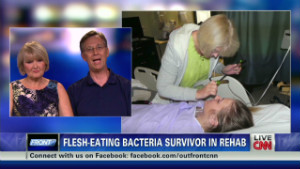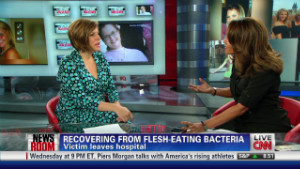"She'll be heading home
this week," said Dr. Spence Taylor, vice president for academics at
Greenville Hospital System. "She's making a great recovery."
Kuykendall, who clasped
hands with her husband, Darren, as she spoke to CNN senior medical
correspondent Elizabeth Cohen, said her recovery has had ups and downs.
"I've had my moments where I've had myself a good cry, but then you just go on," she told CNN.
Darren Kuykendall said family and friends have been caring for the twins, named Ian and Abigail.
Dr. Kevin Kopera, medical director for Roger C. Peace Rehabilitation Hospital, said Lana Kuykendall wanted an aggressive rehabilitation approach.
"That meant three hours
of therapy a day at the minimum," he said. "I initially thought she
would be with us for four to six weeks and she's leaving on day 26
(Tuesday). It took a lot of blood, sweat and tears -- literally."
Lana Kuykendall, wearing a blue T-shirt that read "FAITH HOPE LANA,"
said the day after getting the babies home from the hospital she
noticed what looked like a bruise on her leg. When Kuykendall, a nurse
and paramedic, inspected it closer she thought it might be a blood clot,
and she had her husband, a firefighter and EMT, take her to the
hospital.
"Fortunately she had the good sense to notice this was more serious than usual," said epidemiologist Dr. Bill Kelly.
Doctors there outlined
the spot with a pen and saw the discolored area move. They took her to
surgery, while one of the doctors told Darren Kuykendall how serious her
condition actually was.
Lana Kuykendall said she
doesn't dwell on why this happened to her. A friend of the Kuykendalls'
had a similar case in 2007. That showed her it is an opportunistic
disease, she said.
"There's no point in asking, 'Why me?' " she told CNN. "It just happens."
She still faces months of in-home and then outpatient rehab, Kopera said.
 Aimee Copeland's new phase in recovery
Aimee Copeland's new phase in recovery
 Second case of flesh-eating bacteria
Second case of flesh-eating bacteria
 Flesh-eating bacteria survivor in rehab
Flesh-eating bacteria survivor in rehab
Kuykendall was diagnosed
with necrotizing fasciitis on May 11, four days after giving birth, and
taken to Greenville Memorial Hospital. She has undergone more than 20
surgical procedures, including skin grafts and reconstructive surgery.
But she did not require any amputations, as recently occurred in the
case of 24-year-old Aimee Copeland of Georgia, who lost her hands, a leg
and a foot as a result of the infection.
A number of bacteria,
which are common in the environment but rarely cause serious infections,
can lead to the disease. When the bacteria get into the bloodstream --
such as through a cut -- doctors typically move aggressively to excise
even healthy tissue near the infection site in hopes of ensuring none of
the dangerous bacteria remain.
The disease attacks and
destroys healthy tissue and is fatal in about 20% of cases, according to
the Centers for Disease Control and Prevention.
According to Dr. William
Schaffner, chairman of the Department of Preventive Medicine at the
Vanderbilt University Medical Center, fewer than 250 such cases occur
each year in the United States, though estimates are imprecise because
doctors aren't required to report the cases to health authorities.
No comments:
Post a Comment